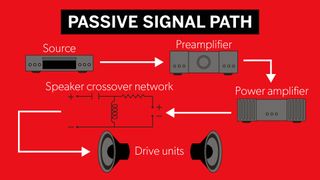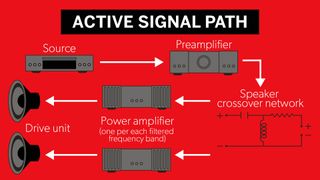Passive speakers

First, there’s a source component, which is the piece of kit that plays the music. This can be a CD player, music streamer, record player or even a computer or phone. Next we have a preamplifier section, this switches between sources and controls the volume level.
If you have a record player, you’ll also need a phono stage to increase the output from your cartridge to line level and equalise the signal before feeding it to the preamp circuit (we’ve omitted the phono stage from our diagram to keep things simple).
Now you need muscle, something that can take the line-level signal from the preamp and increase it enough to drive a pair of speakers – say hello to the power amplifier. However, this isn’t directly connected to your speaker’s drive units.
Its output has to pass through a crossover filter network that in a two-way speaker splits the signal into just high frequencies (to go to the tweeter) and everything else for the larger mid/bass unit.
If you have a three-way speaker, then the crossover splits the sound up into three parts – treble, midrange and bass. This crossover network doesn’t need a power source to work, and in that sense it is considered passive. That’s more or less the signal path in a conventional passive set-up.
Active speakers

In an active system things are the same until after the preamp stage. The signal from the preamp goes into an active crossover network. While this performs the same job as the crossover in the passive set-up it works at line level (around 2v) rather than speaker level (typically 15-35v).
Working at lower signal levels means the components used can be optimised for precision rather than power handling. Such a design would normally use active components, and on more sophisticated products, some form of signal processing (whether digital or not) to get the best out of the drive units.
The result is a filter network that is (potentially) way more accurate in its operation, and delivers a better integrated and optimised sound.
Each separated frequency band of this line-level signal is then sent to a dedicated power amp that feeds as many drive units as are responsible for delivering those frequencies.
This article originally appeared on What Hi-Fi.


